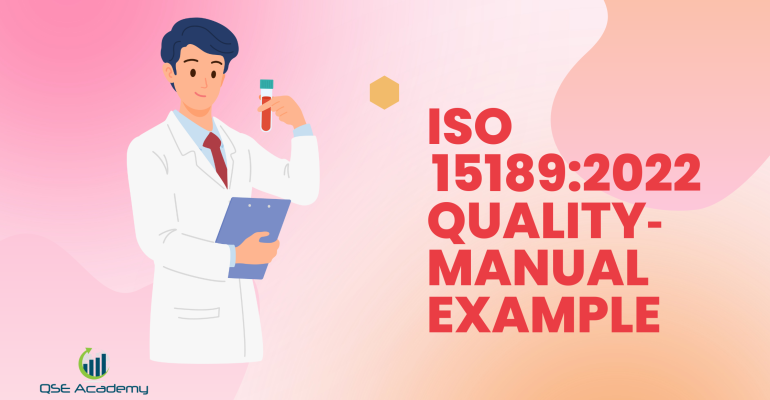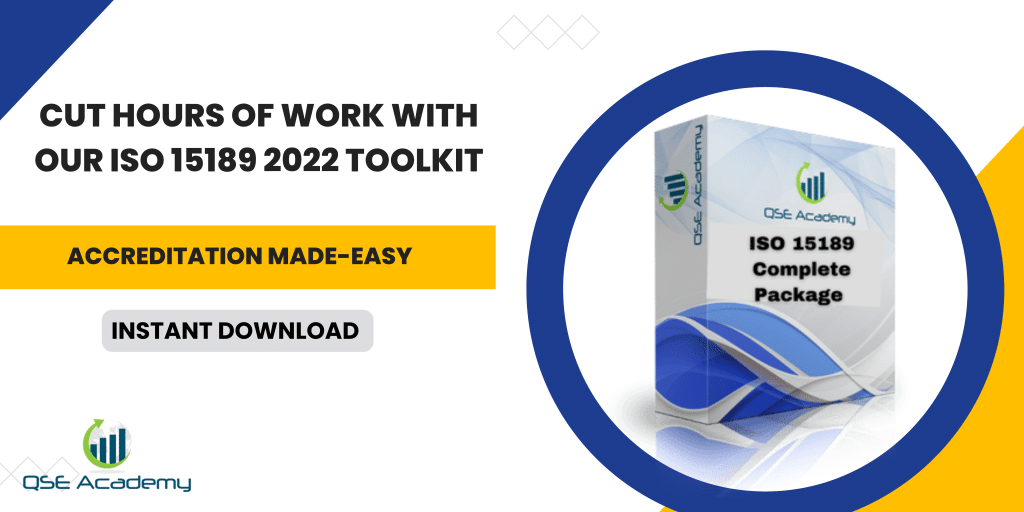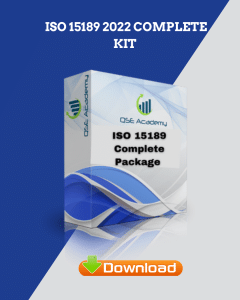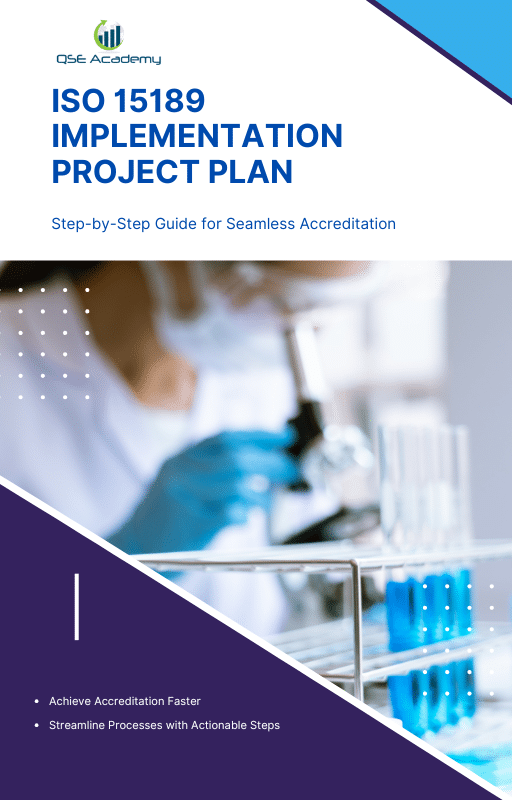ISO 15189:2022 Quality‑Manual Example
Last Updated on October 22, 2025 by Hafsa J.
Why Every Laboratory Needs a Quality Manual That Works
Every lab I’ve helped with ISO 15189 accreditation eventually hits the same wall — the quality manual.
Some write one that’s a hundred pages long, full of copied clauses that no one reads. Others skip key sections altogether, thinking it’s “not mandatory anymore.” Both approaches create the same problem: a manual that doesn’t actually help the lab run better.
Here’s what I’ve noticed after guiding dozens of clinical and testing laboratories:
The most successful ones treat their quality manual as a living guidebook, not a formality. It’s the top-level document that tells the story of how your lab ensures reliable results, competent staff, and continuous improvement.
If you’re working on your ISO 15189:2022 documentation, this article will show you exactly:
-
What the standard expects from your quality manual.
-
How to organize it so it’s easy to use and easy to audit.
-
A simple, real-world example of how an effective manual looks.
Think of it as your roadmap to build a manual that people actually read — and auditors actually appreciate.
Understanding the Role of the Quality Manual in ISO 15189:2022
Here’s the truth: your quality manual isn’t just another binder to tick a box. It’s the blueprint of how your entire laboratory operates under ISO 15189.
In the 2022 version, ISO moved away from overly prescriptive documentation rules, but that doesn’t make the manual optional. Instead, it’s now your strategic overview — the one document that ties together your policies, procedures, and quality objectives in a way that makes sense for your lab.
Think of it like this:
If a new staff member or external assessor walks in tomorrow, your quality manual should help them understand what your lab does, how it does it, and who’s responsible for each part.
What the Manual Should Do
-
Explain how your lab meets the standard’s requirements without copying them.
-
Serve as the entry point to your QMS — linking policies, procedures, and records.
-
Define the boundaries of your quality system (your scope).
-
Reflect your actual processes, not a generic version of the standard.
Pro Tip:
Treat your manual as a living document — update it whenever your organization changes, not just before an audit. Outdated manuals are one of the easiest ways to lose credibility during assessment.
Common Mistake:
Many labs write their manuals like an ISO textbook, repeating clause after clause. Assessors don’t want to read the standard — they want to see how you apply it.
In my experience:
When we helped a small molecular testing lab revise its manual, we focused on describing what actually happens — not what the standard says. During their next audit, the assessor said, “I understood your lab in ten minutes flat.” That’s exactly what a good manual should do.
Required Contents of an ISO 15189:2022 Quality Manual
Let’s break this down clearly — ISO 15189:2022 doesn’t hand you a ready-made checklist for your quality manual. But it absolutely expects your manual to cover certain fundamentals that show how your laboratory ensures quality and competence.
Your manual should act as a map of your management system, showing how everything connects — from leadership to technical work. Below is a practical outline you can adapt for your own lab:
| Section | What to Include | Why It Matters |
|---|---|---|
| Scope & Application | Describe the type of testing, locations, and services your lab provides. | Defines what your quality system covers and what it doesn’t. |
| Organizational Structure | Add an org chart and explain key roles, responsibilities, and authority. | Demonstrates accountability and clear reporting lines. |
| Quality Policy & Objectives | State your lab’s quality goals and commitments. | Provides leadership direction and sets expectations. |
| Document & Record Control | Explain how documents are created, approved, and maintained. | Ensures everyone uses the latest, approved information. |
| Risk & Opportunity Management | Outline how you identify, evaluate, and mitigate risks. | Shows proactive thinking — a big focus in the 2022 version. |
| Key Procedures Reference | List all mandatory procedures (internal audit, corrective action, management review, etc.). | Helps assessors trace compliance quickly. |
| Process Overview | Briefly summarize how your lab handles pre-examination, examination, and post-examination activities. | Proves consistency from start to finish. |
| Confidentiality & Impartiality Policy | Declare how you protect patient information and avoid conflicts of interest. | Demonstrates ethical integrity — critical for accreditation. |
Pro Tip:
Keep your manual high-level. Don’t cram in the full text of every procedure — instead, link to them. Use references like “See Procedure QP-07: Internal Audit Process.” It keeps your manual readable and your QMS organized.
Common Pitfall:
Copying every clause from ISO 15189 into your manual. That doesn’t show understanding — it shows copy-paste. Describe how your lab meets each requirement, not what the requirement is.
In my experience:
Labs that use a clear structure like this finish their documentation faster and perform better during audits. Assessors can follow the logic, and staff can actually use the manual day-to-day — not just once a year during assessments.
Example – Simple, Effective Quality Manual Structure
Here’s the part most labs overcomplicate — the actual structure. Your quality manual doesn’t need to be long to be powerful. It needs to be logical, consistent, and easy to navigate.
I’ve helped labs pass accreditation with manuals under 30 pages — not because they skipped content, but because they wrote it clearly and linked supporting procedures instead of repeating them.
Here’s a practical structure you can model your own manual after:
Example Layout:
-
Quality Policy
A short statement from management outlining your lab’s commitment to accuracy, impartiality, confidentiality, and continuous improvement. -
Scope of the Quality Management System
Describe your lab’s services — types of testing, areas of operation, and any exclusions (if applicable). -
Organizational Structure and Responsibilities
Include an organization chart and describe key roles, reporting lines, and authority levels. -
Management System Processes
-
Document & Record Control
-
Internal Audits
-
Corrective and Preventive Actions
-
Management Review
These subsections describe how your lab controls and monitors the system.
-
-
Technical Processes
-
Pre-Examination (sample collection, transport, and acceptance)
-
Examination (testing, validation, and verification)
-
Post-Examination (reporting, communication, and archiving)
-
-
Risk Management and Improvement
Outline your risk identification and continuous improvement process. -
Annexes and References
-
Controlled Document List
-
Process Maps and Flowcharts
-
Glossary of Terms
-
Clause Cross-Reference Table
-
Pro Tip:
Use hyperlinks if your manual is electronic. For instance, clicking “Internal Audit Procedure” should take you directly to the document. Auditors love that level of clarity and accessibility.
In my experience:
I once worked with a clinical chemistry lab that trimmed its bloated 120-page manual down to 25 concise pages. They moved all detailed procedures to annexes and added cross-references. During the next audit, the assessor called it “the most user-friendly manual I’ve reviewed in years.”
That’s the goal — not to impress with volume, but to show clear, real-world control of your system.
Aligning Your Quality Manual with ISO 15189:2022 Clauses
Here’s where most labs either shine or struggle — mapping their manual to the standard.
ISO 15189:2022 isn’t about copying clauses word for word; it’s about proving that your manual covers every requirement in a way that fits your operations.
Think of your manual as the GPS of your management system. Each section should point directly to the relevant ISO 15189 clause, so assessors can easily trace compliance.
How to Align Your Manual:
| Manual Section | ISO 15189:2022 Clause Reference | Purpose of Alignment |
|---|---|---|
| Scope & Application | Clause 1 and 4.1 | Defines boundaries and services your QMS applies to. |
| Leadership & Responsibilities | Clause 5 | Demonstrates management commitment, accountability, and decision authority. |
| Resource Management | Clause 6 | Shows how competence, equipment, facilities, and supplies are controlled. |
| Process Requirements | Clause 7 | Explains how testing activities (pre-, examination, post-) are managed. |
| Management System | Clause 8 | Links your procedures for audits, corrective actions, and reviews. |
Pro Tip:
Add a Clause Cross-Reference Table at the end of your manual. It’s one of the most underrated audit tools. When assessors ask, “Where do you address Clause 7.5 on verification of examination procedures?”—you can show them exactly where.
Common Mistake:
Some labs force every clause into the manual, even when they already have a dedicated procedure. Don’t duplicate — reference instead. The manual should summarize and link, not repeat.
Example:
At one client’s hematology lab, we created a one-page “Clause Reference Matrix” listing each ISO 15189 clause and where it appears in the manual or related procedure. The assessor flipped through it during the audit and said, “This just made my job easier.” That’s a win in any audit room.
Writing Style & Layout Tips for a Professional Manual
Now that you know what to include, let’s talk about how to make your quality manual clear, usable, and professional. A well-written manual doesn’t just satisfy auditors—it guides your team and strengthens your lab’s consistency.
When I review manuals, I can usually tell in the first few pages whether they were written by someone who understands the lab or by someone copying the standard. The difference always comes down to clarity, tone, and structure.
Keep It Clear and Practical
Your manual should describe what your lab does, not repeat what ISO says.
Use straightforward language and short sentences. For example:
-
Correct: “Our laboratory verifies each new test method before release.”
-
Incorrect: “Verification of methods shall be conducted prior to implementation.”
Pro Tip:
Read your manual aloud. If it sounds stiff or confusing, rewrite it. Staff should be able to understand it without re-reading.
Structure for Readability
Make it easy to navigate. A clear structure saves time during audits and internal reviews.
Layout Essentials:
-
Consistent section numbering and headers.
-
Version control on every page (revision number, approval date, author).
-
A hyperlinked table of contents if it’s digital.
-
Signature or approval pages for top management.
Pro Tip:
Visuals help. A single flowchart can replace several paragraphs of text. Use diagrams for key processes like document control or sample handling.
Make It Reflect Your Laboratory
Avoid generic language. Use first-person phrasing like “Our laboratory ensures…” or “We maintain…” to show ownership.
Common Mistake:
Copying a template without customizing it. Auditors notice when your manual mentions equipment or departments you don’t have.
In My Experience:
I once reviewed a lab’s manual that referenced “gas chromatography” in three places—even though they only did microbiology testing. It immediately raised red flags during their audit. After rewriting it in their own voice, the document finally felt authentic and passed without issue.
Add Professional Finishing Touches
Include your logo, document title, and footer with “Controlled Document.” Keep a “Revision History” page at the end to show updates and improvement.
Pro Tip:
Review the manual at least once a year or after any major change in processes or personnel. Nothing undermines confidence faster than an outdated “current version.”
Real-World Case Example – What a Good Manual Looks Like
Sometimes the easiest way to understand what works is to see it in action.
A few years ago, I worked with a regional diagnostics lab that had been struggling through its ISO 15189 transition. Their manual was nearly 130 pages long, full of copied text and overlapping procedures. Nobody in the lab could find what they needed, and every audit felt like starting from zero.
We stripped it down to the essentials: 28 pages, clean layout, and direct links to the actual procedures. Each section explained what their team did—not what the standard said. We used process maps instead of paragraphs and added a clause-reference matrix at the back.
When the assessor arrived, the feedback was simple:
“This manual actually describes your lab. I can follow the workflow from sample receipt to report release without asking a single clarification.”
That one comment said everything. The lab passed the audit with only minor observations and has kept the same structure ever since.
Lesson:
A quality manual isn’t meant to impress with length or language. Its value is in clarity and accuracy. The moment your team and auditor can both navigate it easily, you’ve done it right.
FAQs – ISO 15189:2022 Quality Manual
Q1: Is a quality manual still mandatory under ISO 15189:2022?
Technically, the 2022 version doesn’t use the term “quality manual” the way earlier editions did. But in practice, accreditation bodies still expect a top-level document that explains how your laboratory meets each requirement of the standard.
Whether you call it a “Quality Manual,” “QMS Overview,” or “Management System Description,” it serves the same purpose—showing the structure and intent of your system.
Q2: How long should my quality manual be?
There’s no rule about length. The best manuals I’ve seen are between 20 and 40 pages, depending on the size of the lab.
The key is usability—your staff should be able to find what they need quickly. If your manual takes more than a few seconds to navigate, it’s too long or too dense.
Q3: Can I combine my ISO 15189 manual with ISO 9001 or ISO/IEC 17025?
Yes. In fact, ISO 15189:2022 was updated to align structurally with those standards. If your organization already runs a broader quality system, you can integrate your manuals.
Just make sure each clause is traceable—use cross-references or matrices to prove compliance during audits.
Q4: How often should the manual be updated?
Review it at least once a year, or whenever a significant change occurs—such as new equipment, new services, or organizational restructuring.
Outdated documents are one of the easiest findings to avoid. Keep the manual current, and your audit process becomes much smoother.
Build a Manual That Proves Competence, Not Just Compliance
The best quality manuals don’t read like ISO checklists—they read like a story of how your lab operates with precision and purpose. When written well, your manual becomes a reflection of your team’s competence, not just a set of compliance documents.
A strong ISO 15189:2022 quality manual shows three things clearly:
-
Your lab understands what the standard requires.
-
You’ve built systems that work in practice, not just on paper.
-
Everyone—from technicians to management—knows how their work fits into the bigger picture of quality.
In my experience, labs that keep their manuals concise, structured, and truly reflective of daily operations not only pass audits more easily—they build stronger internal systems that sustain compliance year after year.
If your manual still feels more like a burden than a tool, it’s time to simplify. Start by outlining your processes, link them to the right clauses, and keep your documentation style conversational and functional. The goal isn’t to impress auditors—it’s to make your lab easier to run and easier to trust.
Next step:
Download QSE Academy’s ISO 15189:2022 Quality Manual Template Pack to get a ready-to-use structure, editable examples, and professional formatting that will save you hours of drafting and help you align perfectly with the 2022 standard.
Whether it’s ISO 9001, ISO 22000, or the cosmetics-focused ISO 22716, I’ve spent my career I’m not here to call myself an expert—I prefer “enthusiast” because I truly love what I do. When I’m not writing about standards, you’ll probably find me playing Piano 🎹, connecting with people, or diving into my next big project💫. I’m an engineer specialized in the food and agricultural industry
make ISO standards less intimidating and more approachable for everyone.
turning complex jargon into clear, actionable steps that businesses can actually use.
There’s something incredibly rewarding about helping people navigate food safety and quality management systems
in a way that feels simple, practical, and even enjoyable.
I have a Master’s in QHSE management and over 12 years of experience as a Quality Manager
I’ve helped more than 15 companies implement ISO 9001, ISO 22000, ISO 22716, GMP, and other standards
My clients include food producers, cosmetics manufacturers, laboratories, and service companies
I believe quality systems should be simple, useful, and efficient.













